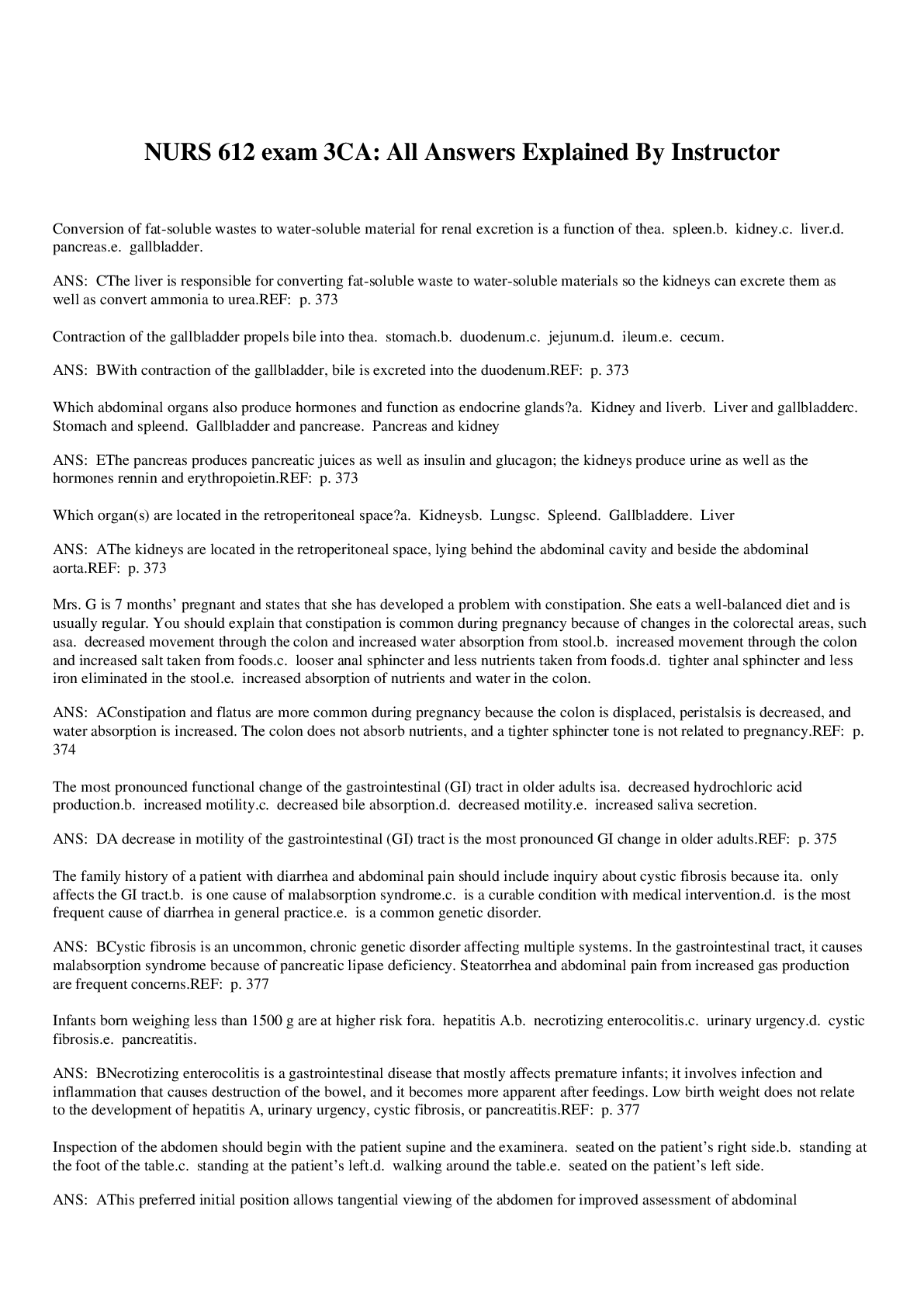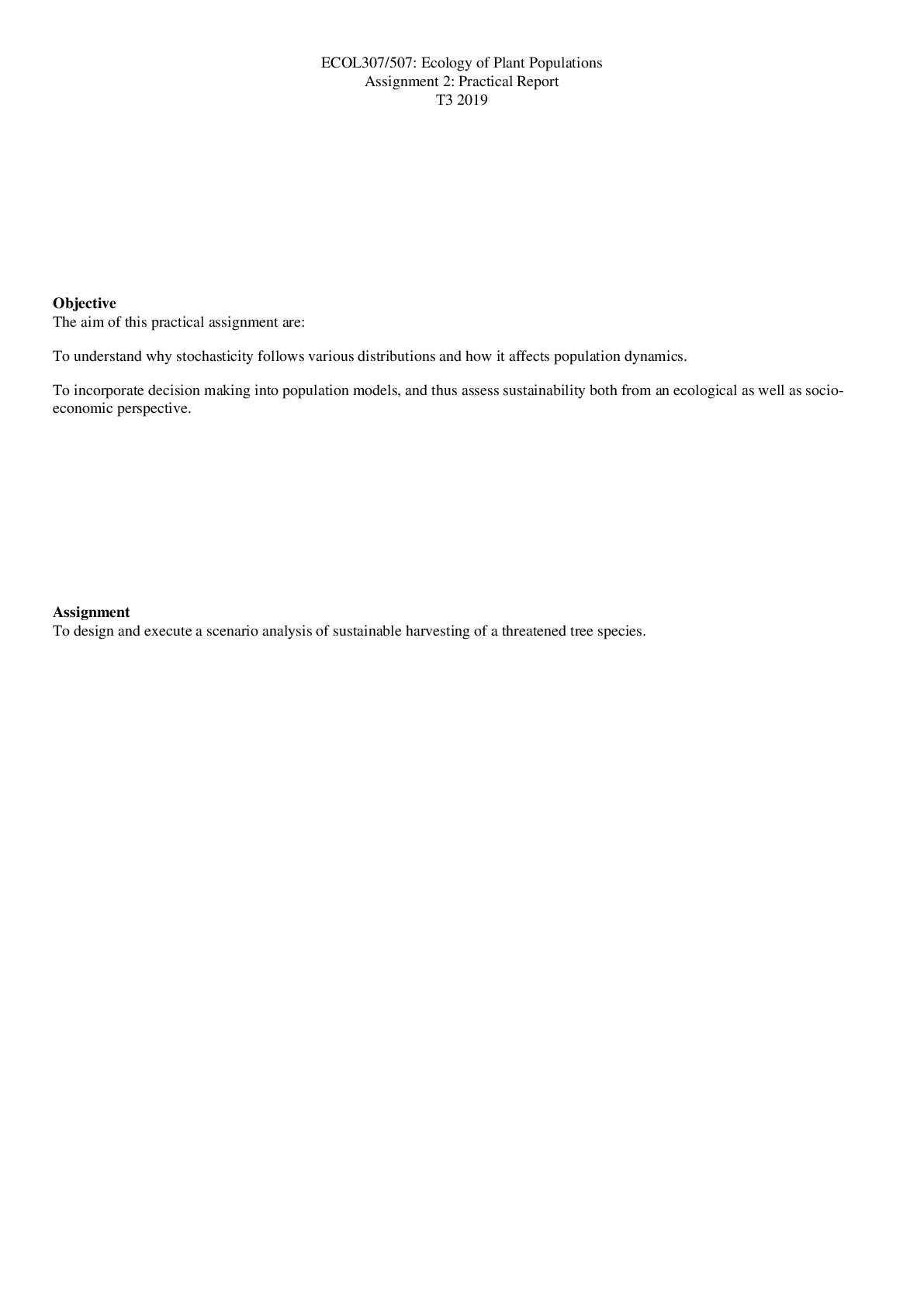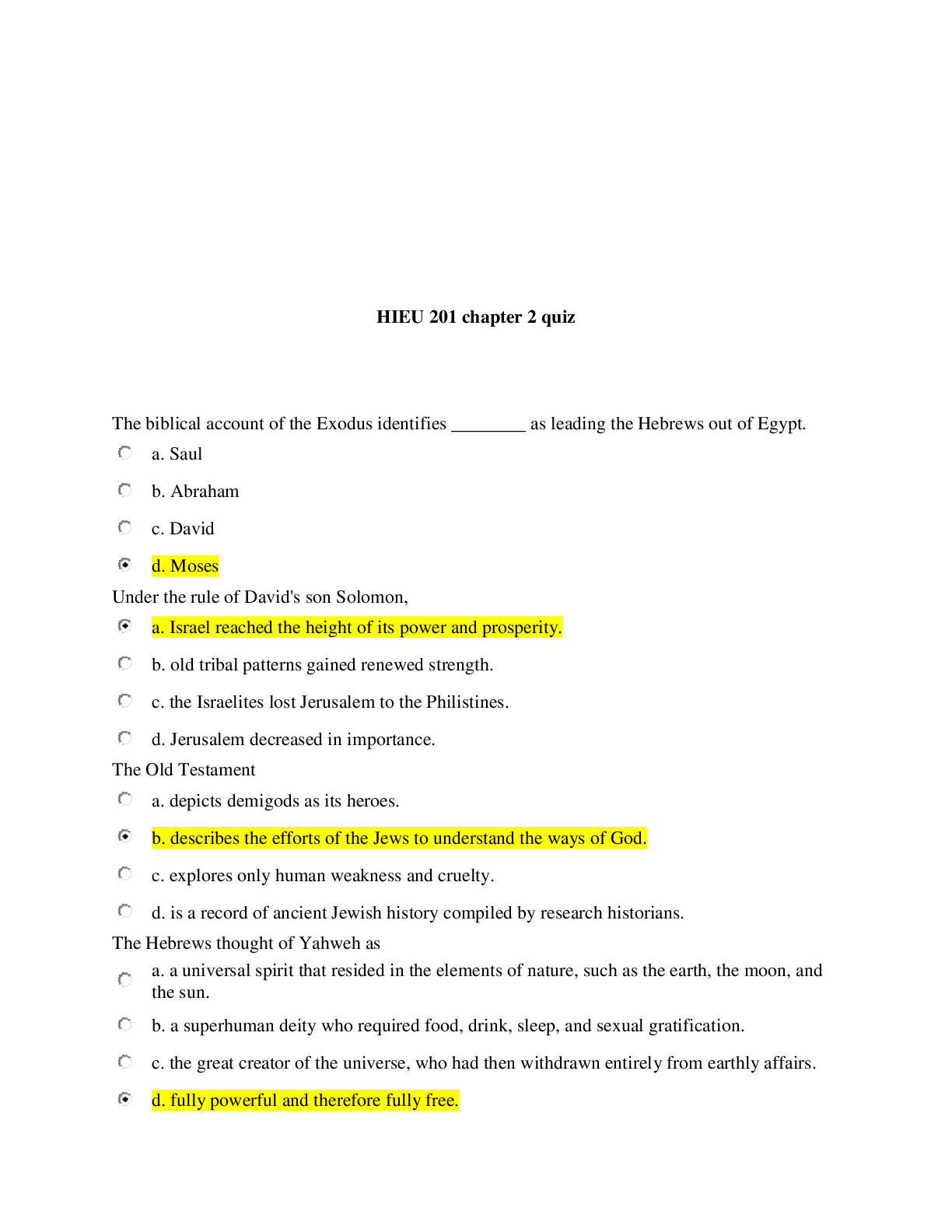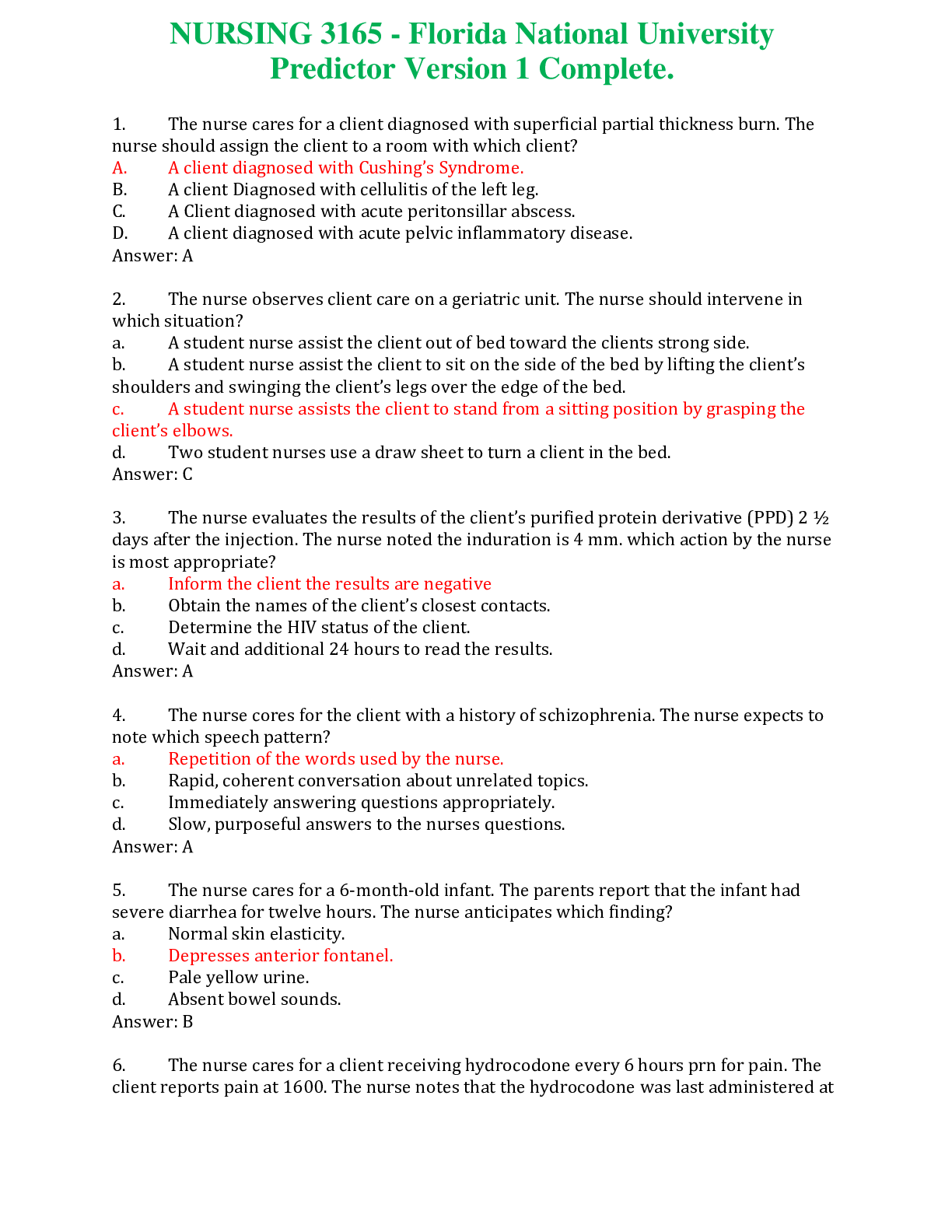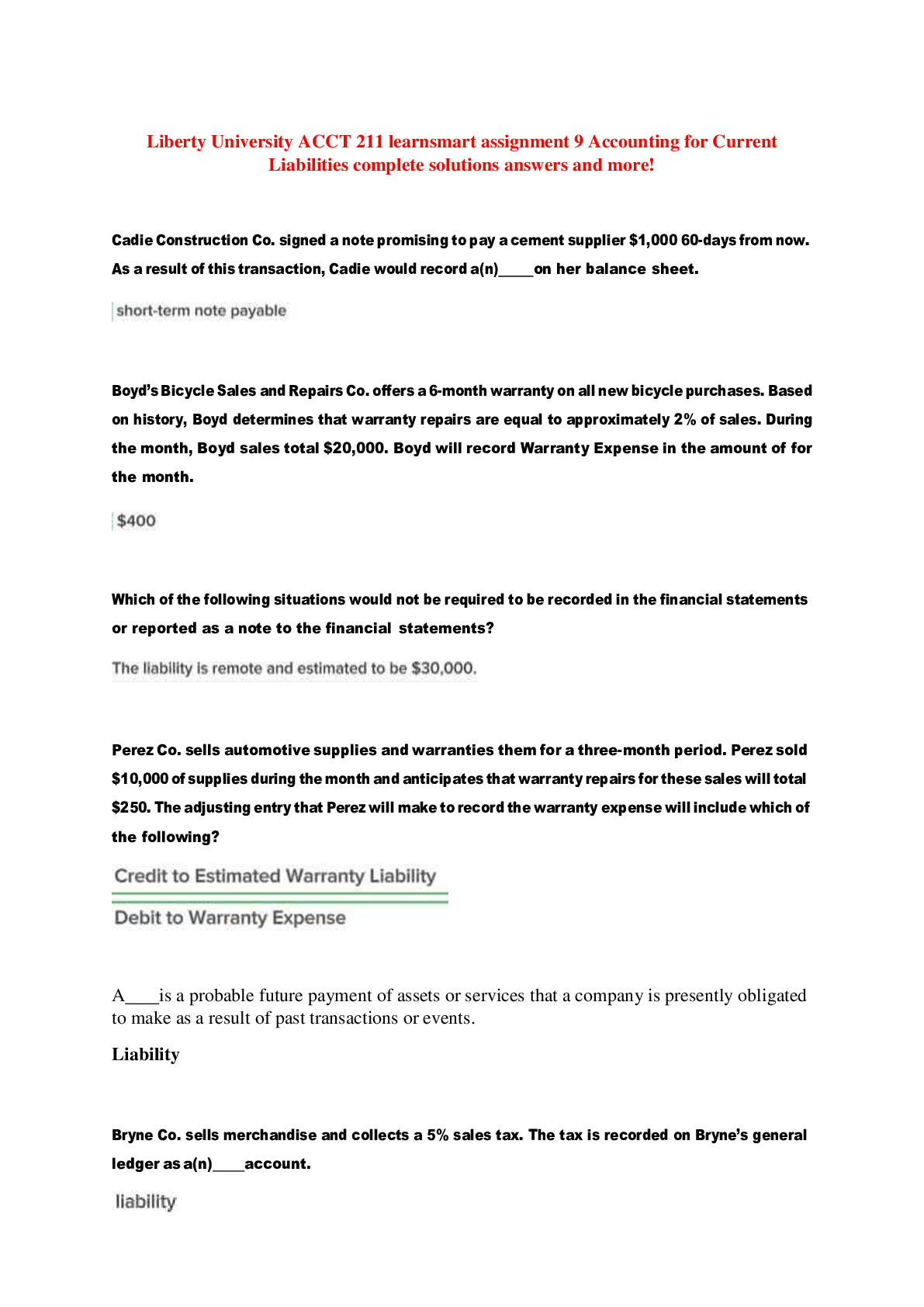Biology > QUESTIONS & ANSWERS > Chapter 22—FUNGI. All Answers (All)
Chapter 22—FUNGI. All Answers
Document Content and Description Below
1. All fungi: a. are decomposers b. perform extracellular digestion c. are parasites d. reproduce sexually e. are multicellular : b POINTS: 1 REFERENCES: Section 22.1 What... is a fungus? KEYWORDS: Bloom's: Remember NOTES: Modified 2. Most fungi are members of which lineages? a. zygote b. chytrid c. club and glomeromycete d. club and sac e. chytrid and glomeromycete : d POINTS: 1 REFERENCES: Section 22.1 What is a fungus? KEYWORDS: Bloom's: Remember NOTES: Modified 3. In most true fungi, the individual cellular filaments of the body are called: a. mycelia b. hyphae c. mycorrhizae d. asci e. yeast : b POINTS: 1 REFERENCES: Section 22.1 What is a fungus? KEYWORDS: Bloom's: Remember 4. Groups of fungal filaments are collectively called: a. mycelia b. hyphae c. mycorrhizae d. asci e. yeast : a POINTS: 1 REFERENCES: Section 22.1 What is a fungus? KEYWORDS: Bloom's: Remember 5. What are soil fungi with hyphae that grow into plant roots and branch inside the cell walls of plant root cells? a. chytrids b. glomeromycetes c. zygote fungi d. sac fungi e. club fungi : b POINTS: 1 REFERENCES: Section 22.1 What is a fungus? KEYWORDS: Bloom's: Remember NOTES: New 6. What is the most diverse fungal group, and includes yeasts, molds, parasites of plants and animals, species that partner with photosynthetic cells to form lichens, etc.? a. chytrids b. glomeromycetes c. zygote fungi d. sac fungi e. club fungi : d POINTS: 1 REFERENCES: Section 22.1 What is a fungus? KEYWORDS: Bloom's: Remember NOTES: New 7. Some fungi live as single cells, called ____. a. hyphae b. hypha c. zygospores d. mycelium e. yeast : e POINTS: 1 REFERENCES: Section 22.1 What is a fungus? KEYWORDS: Bloom's: Remember NOTES: New 8. Multicelled fungi live as a mesh of threadlike filaments collectively called ____. a. hyphae b. hypha c. mycelium d. yeast e. fruiting bodies : c POINTS: 1 REFERENCES: Section 22.1 What is a fungus? KEYWORDS: Bloom's: Remember NOTES: New 9. Fungal cell walls contain: a. lignin b. chitin c. cellulose d. glycogen e. keratin : b POINTS: 1 REFERENCES: Section 22.1 What is a fungus? KEYWORDS: Bloom's: Remember NOTES: New 10. What is the term for a fungus cell that has two genetically distinct types of nuclei? a. diploid b. haploid c. mitotic d. dikaryotic e. monokaryotic : d POINTS: 1 REFERENCES: Section 22.1 What is a fungus? KEYWORDS: Bloom's: Remember NOTES: New 11. When the nuclei in a dikaryotic cell fuse, what happens? a. A haploid zygote is formed. b. A diploid zygote is formed. c. A haploid spore is produced. d. A diploid spore is produced. e. A haploid gametangia forms. : b POINTS: 1 REFERENCES: Section 22.1 What is a fungus? KEYWORDS: Bloom's: Remember NOTES: New 12. Which fungal subgroup includes the oldest fungal lineages, are the only living fungi that make flagellated spores, and function in aquatic decomposition? a. chytrids b. glomeromycetes c. zygote fungi d. sac fungi e. club fungi : a POINTS: 1 REFERENCES: Section 22.1 What is a fungus? KEYWORDS: Bloom's: Remember NOTES: New 13. In fungi, food materials are digested: a. within food vacuoles b. outside the body c. intracellularly d. by the mitochondria e. by the host organism : b POINTS: 1 REFERENCES: Section 22.1 What is a fungus? KEYWORDS: Bloom's: Remember Figure 22.4 Life cycle of black bread mold, a zygote fungus. 14. In Figure 22.4, what chromosome state is stage “C” in? a. diploid (2n) b. haploid (n) c. dikaryotic (n+n) d. diploid (n) e. haploid (2n) : c POINTS: 1 REFERENCES: Section 22.2 How do life cycles differ among fungal groups? KEYWORDS: Bloom's: Understand NOTES: New 15. In Figure 22.4, what chromosome state is stage “A” in? a. diploid (n) b. haploid (2n) c. dikaryotic (n+n) d. diploid (2n) e. haploid (n) : d POINTS: 1 REFERENCES: Section 22.2 How do life cycles differ among fungal groups? KEYWORDS: Bloom's: Understand NOTES: New 16. In Figure 22.4, what chromosome state is stage “B” in? a. diploid (2n) b. haploid (n) c. dikaryotic (n+n) d. diploid (n) e. haploid (2n) : b POINTS: 1 REFERENCES: Section 22.2 How do life cycles differ among fungal groups? KEYWORDS: Bloom's: Understand NOTES: New Figure 22.6 Life cycle of a club fungus. 17. In figure 22.6, a dipolid cell undergoes meiosis to produce ____ in “A”. a. four haploid spores b. four diploid spores c. two haploid spores d. two haploid seeds e. four haploid pollen grains : a POINTS: 1 REFERENCES: Section 22.2 How do life cycles differ among fungal groups? KEYWORDS: Bloom's: Understand NOTES: New 18. In Figure 22.6 “C”, when hyphae of two mushroom-forming club fungi meet, they fuse and form a ____, ____ that continues to grow in the soil and feed by decomposing organic material. a. dikaryotic; fruiting body b. diploid; fruiting body c. dikaryotic; mycelium d. diploid; mycelium e. diploid; club cell : c POINTS: 1 REFERENCES: Section 22.2 How do life cycles differ among fungal groups? KEYWORDS: Bloom's: Understand NOTES: New 19. In Figure 22.6 “E”, how does the club cell become a diploid zygote? a. the club cell is fertilized by sperm b. the club cell is fertilized by the fusion with another club cell c. the club cell divides by meiosis d. the club cell absorbs a nucleus from a neighboring club cell e. the two nuclei in the dikaryotic club cell fuse : e POINTS: 1 REFERENCES: Section 22.2 How do life cycles differ among fungal groups? KEYWORDS: Bloom's: Understand NOTES: New 20. What best describes the location where sexual spores form in club fungi? a. in gills of the mushroom b. in club-shaped cells at the gill margin c. in fruiting bodies d. in club-shaped cells of mycelium e. in hyphae of an embryonic mushroom : b POINTS: 1 REFERENCES: Section 22.2 How do life cycles differ among fungal groups? KEYWORDS: Bloom's: Remember NOTES: New 21. As long as food is plentiful, a zygote fungus: a. reproduces sexually b. grows as a diploid organism c. produces spores from an aerial hypha d. forms gametangia e. grows as a haploid mycelium and produces spores by mitosis : e POINTS: 1 REFERENCES: Section 22.2 How do life cycles differ among fungal groups? KEYWORDS: Bloom's: Remember NOTES: New 22. In what way do fungi reproduce? a. asexually by spores only b. budding of the parent body only c. sexually by gametes only d. asexually by spores and budding of the parent body only e. asexually by spores, budding of the parent body, and sexually by gametes : e POINTS: 1 REFERENCES: Section 22.2 How do life cycles differ among fungal groups? KEYWORDS: Bloom's: Remember 23. Which organism is a member of zygospore-forming fungi? a. water mold b. smut or rust c. bread mold d. mushroom e. truffle : c POINTS: 1 REFERENCES: Section 22.2 How do life cycles differ among fungal groups? KEYWORDS: Bloom's: Remember 24. The two nuclei in the dikaryotic state are: a. diploid and from the same parent b. diploid and from different parents c. haploid and from the same parent d. haploid and from different parents e. one diploid and one haploid from different parents : d POINTS: 1 REFERENCES: Section 22.2 How do life cycles differ among fungal groups? KEYWORDS: Bloom's: Remember 25. The main difference between a mature zygospore and a young zygospore is that the young zygospore is: a. haploid b. equivalent to a fruiting body c. diploid d. dikaryotic e. fertilized : d POINTS: 1 REFERENCES: Section 22.2 How do life cycles differ among fungal groups? KEYWORDS: Bloom's: Understand NOTES: Modified Selecting the Exception 26. Four of the five s listed below can be used when describing fungal reproduction. Select the exception. a. budding b. pollen c. dikaryotic d. zygospore e. aerial hypha : b POINTS: 1 REFERENCES: Section 22.2 How do life cycles differ among fungal groups? KEYWORDS: Bloom's: Remember OTHER: Selecting the Exception NOTES: Modified 27. Four of the five terms involve fungus and food. Select the exception: a. mold, blue cheese b. fermentation, soy sauce c. yeast, bread d. truffles, host trees e. soil fungus, penicillin : e POINTS: 1 REFERENCES: Section 22.4 How do we use fungi? KEYWORDS: Bloom's: Understand NOTES: New 28. Four of the five s are edible mycorrhizal fungi. Select the exception. a. chanterelles b. truffles c. shiitake mushrooms d. porcini mushrooms e. morels : c POINTS: 1 REFERENCES: Section 22.4 How do we use fungi? KEYWORDS: Bloom's: Remember NOTES: New 29. Which factor is the most important algal contribution to the fungal component of a lichen? a. improved water conservation b. mechanical protection from being blown away c. photosynthetically derived food d. less overlap among individual algal cells e. pigment for camouflage : c POINTS: 1 REFERENCES: Section 22.3 What ecological roles do fungi play? KEYWORDS: Bloom's: Understand 30. A lichen is a composite organism made up of: a. two different fungi b. a fungus and an autotroph c. a fungus and a gymnosperm d. a fungus and an amoeba e. a fungus and a sporozoan : b POINTS: 1 REFERENCES: Section 22.3 What ecological roles do fungi play? KEYWORDS: Bloom's: Understand 31. The first colonizers of bare rock are often: a. angiosperms b. lichens c. mycorrhizae d. sac fungi e. zygote fungi : b POINTS: 1 REFERENCES: Section 22.3 What ecological roles do fungi play? KEYWORDS: Bloom's: Remember 32. The organisms that make up lichen: a. benefit from each other b. infect human body surfaces c. increase the surface area of plant partners d. obtain sugar by fungal photosynthesis e. are plant parasites : a POINTS: 1 REFERENCES: Section 22.3 What ecological roles do fungi play? KEYWORDS: Bloom's: Understand 33. Glomeromycete fungi and plants take part in a mycorrhiza that _____. a. benefits the plant, but harms the fungus b. benefits the fungus, but harms the plant c. harms both the plant and the fungus d. allows the fungus to use its host to disperse spores e. benefits both the plant and the fungus : e POINTS: 1 REFERENCES: Section 22.3 What ecological roles do fungi play? KEYWORDS: Bloom's: Understand 34. Where are the fungal hyphae in a mycorrhiza? a. the space between the cell wall and the plasma membrane of root cells. b. in the cytoplasm of root cells. c. on the surface of plant stems, above ground. d. within the vasculature of the leaves of a plant. e. on the outside of the cell wall of root cells. : a POINTS: 1 REFERENCES: Section 22.3 What ecological roles do fungi play? KEYWORDS: Bloom's: Remember NOTES: New 35. Algae are to lichens as ____ are to mycorrhizae. a. club fungi b. tree roots c. water molds d. plant leaves e. mosses 36. How do plants benefit from a mycorrhizal partnership with a soil fungus? a. the fungus provides sugars b. the fungus participates in photosynthesis c. they provide digestive enzymes d. they increase the absorptive surface area of the plant and provide water and nutrients e. the protect the plant from pathogens 37. Geneticists discovered checkpoint genes involved in the cell cycle by studying the process in ____. a. yeast b. chytrids c. zygote fungi d. mycorrhizal fungi e. bacteria 38. Most edible fungi come from the fungal group that also contains: a. poisonous mushrooms b. lichen c. penicillin d. bread mold e. glomeromycetes 39. A fungus that has been implicated in frog population declines worldwide is a member of the _____ group. a. club fungi b. chytrid c. zygote fungi d. glomeromycetes e. sac fungi 40. The fungus, Batrachochytrium dendrobatidis, is a chytrid that infects and kills frogs in North America. It is an example of: a. a parasite b. a toxin c. a decomposer d. a fermenter e. a mycorrhizal fungus 41. Figure 22.3 Relationships among major fungal groups. Label the five major subgroups of fungi: A: ____ B: ____ C: ____ D: ____ E: ____ Figure 22.4 Life cycle of black bread mold, a zygote fungus. 42. In the accompanying figure, what is represented by “D”? 43. a. In the accompanying figure, what is represented by “E”? b. When does this structure form? c. What concentrates at the tips of these structures? 44. Describe some of the relationships fungi have with other organisms. 45. What makes fungi important decomposers? Figure 22.6 Life cycle of a club fungus. 46. In the accompanying figure, what is happening at step “B”? 47. How is a zygospore formed in the life cycle of a zygote fungus? How does it progress from a young zygospore to a mature zygospore? 48. Describe some naturally occurring fungal compounds have medicinal properties. 49. the following questions. a. Are fungal spores haploid (n) or diploid (2n)? b. Are fungal spores produced asexually or sexually? 50. What structural characteristic allows sac fungi and club fungi to include larger-bodied species than other fungal groups? 51. Mycelia of some mushroom-forming club fungi extend for miles growing underground. Embryonic mushrooms then form on the mycelium. What happens when it rains? 52. What important ecological role do lichens play? 53. Bacteria are abundant and useful decomposers. What are fungal decomposers able to do better than bacteria? 54. One of the leading causes of death among early botanists was mushroom poisoning from eating a poisonous variety of club fungi. What is a possible explanation for this interesting fact? Choose the most appropriate letter for each. a. produce toxins that kill plant tissues b. bakers yeast c. human fungal vaginitis d. black bread mold e. resulting loss of nutrients stunts the plant, prevents it from producing seeds, and may eventually kill it f. soy sauce fermentation g. edible mycorrhizal fungi REFERENCES: Section 22.3 What ecological roles do fungi play? Section 22.4 How do we use fungi? KEYWORDS: Bloom's: Remember NOTES: New 55. plant parasite : e POINTS: 1 56. truffles : g POINTS: 1 57. Saccharomyces cerevisiae : b POINTS: 1 58. Aspergillus : f POINTS: 1 59. zygote fungus : d POINTS: 1 60. Candida : c POINTS: 1 61. pathogenic fungi : a POINTS: 1 [Show More]
Last updated: 1 year ago
Preview 1 out of 19 pages
Instant download
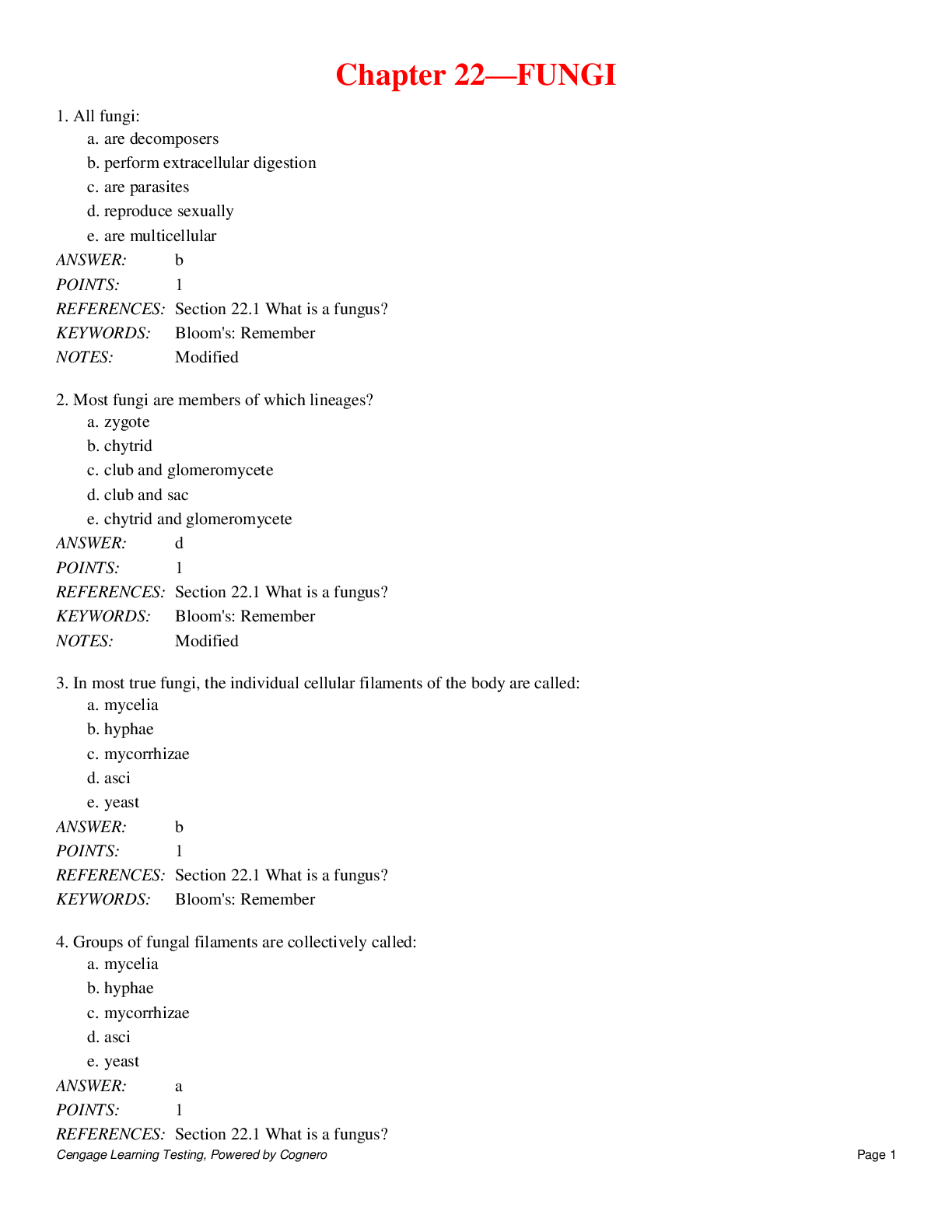
Buy this document to get the full access instantly
Instant Download Access after purchase
Add to cartInstant download
Reviews( 0 )
Document information
Connected school, study & course
About the document
Uploaded On
Nov 27, 2019
Number of pages
19
Written in
Additional information
This document has been written for:
Uploaded
Nov 27, 2019
Downloads
0
Views
74













